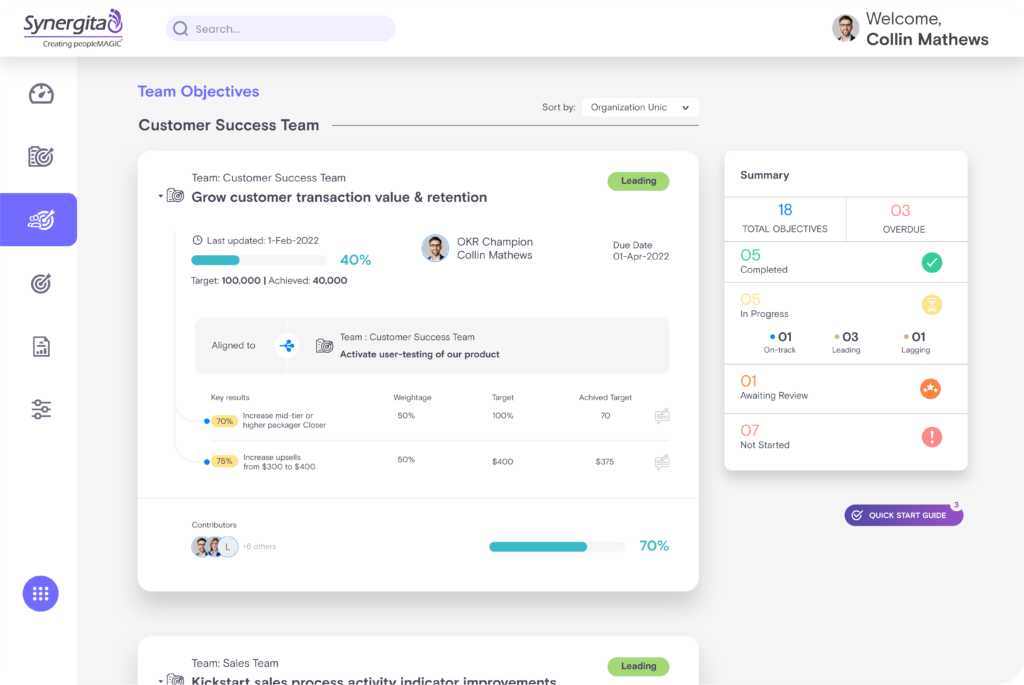What are Some of the Key OKR Examples for HR Operations?
Take a walk by your HR department, and you probably see them engrossed in making calls, setting up meetings and scouring for the best available talent in the market. Without them, talent management for organisations would be like walking through an endless maze. As everyone knows by now, HR teams are crucial to attracting and developing a skilled workforce. This entails:
- Making sure the right people are hired
- Keeping employees constantly engaged and motivated
- Creating an inclusive environment to retain diverse talent
- Incubating a process that values outcomes, teamwork, and collaboration
So, one of the best ways to organise the HR team’s priorities and direct efforts in the right direction is to create HR OKRs. OKRs help HR teams establish a data-driven approach to attaining and supporting overall corporate objectives. This blog post will cover the purpose of HR OKRs, why you should set them, best practices and examples of helpful HR OKRs.

Why do HR departments require OKRs?
It is the responsibility of the HR department to ensure consistent enhancements to the employee experience and to find the best talent. While your HR departments may be functioning at the right pace and meeting current expectations, the fact is that they can level up their game with the right set of HR OKRs.
HR professionals can leverage data from OKRs to devise strategies and initiatives that drive overall company objectives. OKRs also help HR teams gain support from top management by providing leadership with a clear picture of how HR-specific key results propel business objectives. Additionally, OKRs help quantifies “soft” metrics like engagement, wellness, cooperation, collaboration, and feedback.
Using metrics to guide your HR initiatives, you can assess the degree to which HR-related decisions are backed by data rather than intuition. With the help of HR OKRs, your HR teams can continuously evaluate, enhance, and even transform your business.
The art of creating successful OKRs for Human Resources
Knowing what your organisation needs most will help you decide on an OKR priority area for HR:
Organisational needs may look like this:
- Identifying growth-inhibiting areas
- Sustaining momentum and ensuring balance
- Going above and above in a particular area to get a competitive advantage
Although your organisation’s needs are rarely one-dimensional, OKRs help HR departments identify areas for improvement through data insights. By observing how data-driven key results changes from quarter to quarter, your HR staff will be able to identify which initiatives are effective, where improvement is required, and how the OKRs may need to be tweaked.
The best practices while setting up OKRs for HR
1. Align your HR OKRs with the organisation’s objectives
As your primary objective is to add value to the business, the best practice is to match your HR OKRs to the larger organisational OKRs. Later translate these OKRs to your sub-departments (Recruitment, HR Operations, L&D, etc.). You may need to work closely with different departments to achieve some objectives (such as providing the best digital HR services in the world). The key results that contribute to achieving this goal can be handled cross-functionally.
2. Include SMART goals
A successful OKR should include a purposeful objective and SMART (Specific, Measurable, Achievable, Relevant, Time-Bound) key results that help achieve the objective. An effective HR OKR should be measurable, reasonable, aspirational, and verifiable. It should also promote growth and development.
3. Devise strategic OKRs
Your OKRs are designed to steer your company in the right direction. It must therefore include elements of planning, reviewing, and providing feedback.
4. Determine a reasonable number of key results for each objective
For each objective, have about 2 to 5 key results. If you include more key results, your team members may lose focus.
5. Assign a value to key results
By assigning an OKR a percentage weight, you can prioritise everyday tasks and activities. Additionally, it enables you to hold multiple departments responsible and assess how much of your objective you have accomplished.
Now that you know the best practices to set up OKRs for HR, here are a few examples of HR OKRs to get you started.
A few HR OKR examples to understand how they work
| AREA OF FOCUS | OBJECTIVE | KEY RESULTS |
| Performance Management | Enhance team performance | Key result 1 – Boost team members’ OKR completion rates from 60% to 70%. Key result 2– Increase participation in the weekly check-ins from 80% to 100%. Key result 3 – Increase the product teams’ velocity from 100 to 125. |
| Benefits and Compensation | Attract better talent | Key result 1 – By Q3, ensure that 80% of positions are in the appropriate pay bands. Key result 2- By Q4, ensure gender pay parity. Key result 3- Increase salary satisfaction levels from 40% to 60%. |
| Hiring and Recruiting | Enhance the recruiting process | Key result 1- Decrease the lead time for the vacancy from 45 to 30 days. Key result 2- Increase offer acceptance rate from 80% to 90%. Key result 3- Increase internal recommendations by 30%. |
Enhance your HR OKRs for organisational success
It can certainly be challenging to develop effective and well-structured OKRs. However, if you have the patience to carry out numerous iterative improvement cycles, you will see how HR OKRs will increase team engagement, motivation, and output.
If you want to enhance your HR team’s functioning and assess how well they are meeting their objectives, it would be a smart move to invest in an OKR tracking tool. For instance, with Synergita’s simple and effective OKR tracking software, you no longer have to worry about whether your team’s performance can be managed and sustained the right way. It will help keep them focused and align their tasks with your organisation’s goals and objectives.
